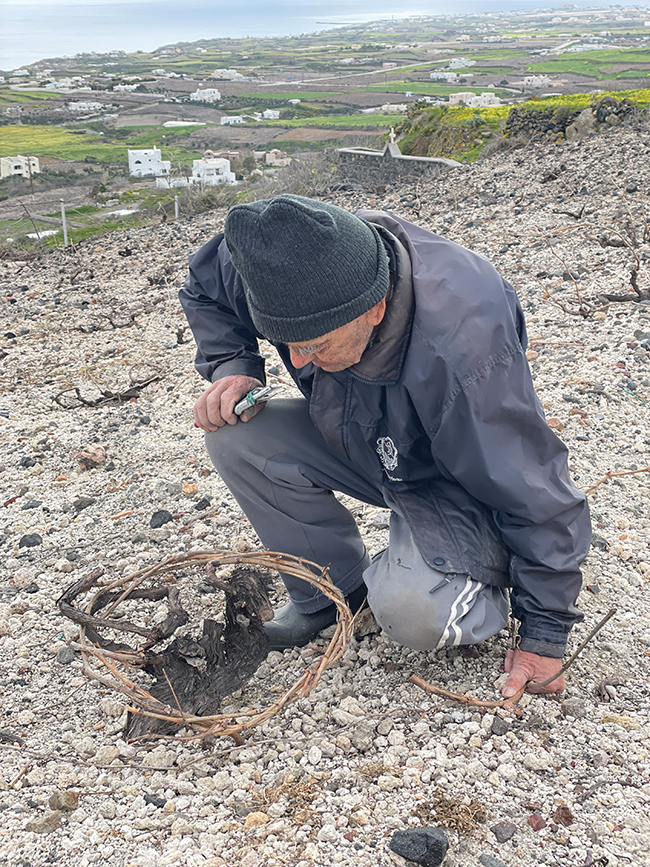
PDO Santorini: A mythological terroir
Welcome to an island like no other, where winemaking terroir and traditions are like nowhere else on Earth.
In Greek mythology, Santorini was created by Euphemus. While resting on the island of Anaphe he dreamt that he made love to a nymph, the daughter of the sea god, Triton. The nymph fell pregnant, and fearing her father’s wrath, she asked Euphemus to throw a clod of earth from Anaphe into the Aegean Sea. A haven where she could give birth and raise their child would magically be formed. When Euphemus woke up he did as he was asked in the dream. The earth was thrown, and a stunning island emerged from the sea. It was named Calliste (Kalliste), meaning ‘most beautiful’.
The myth, though fantastical, has fact in its fiction. Santorini is the site of one of the largest volcanic eruptions in history, taking place some 3,600 years ago. The Minoan settlements on a single island were devastated and the water-filled caldera that is Santorini was formed.
To know this is to understand the unique soil that distinguishes the Protected Designation of Origin (PDO) Santorini wines. The eruption left behind a mix of volcanic ash, pumice stone and clumps of solidified lava and sand. Together they make a soil known as ‘aspa’.
This soil has almost no moisture capacity, almost no organic matter, yet is rich in minerals. Importantly, it has no potassium, which yields wines that have low pH levels and brilliantly vivid acidity.
TERROIR ABOVE AND BEYOND SOIL
Barely 10 miles long and never more than 3 miles wide, Santorini is a small island, buffeted by strong sea winds on all sides. The cool meltemia wind arrives from the north, giving respite from the heat at the same time as keeping viticultural headaches, like mildew, at bay.
It will come as no surprise to learn that phylloxera has never visited Santorini.
Rain is scarce, exceeding no more than 400mm a year. Vines capture moisture from the sea fog and the porous soils cannily store what water comes, releasing it from the depths in the all-crucial growing season.
Climatically, Santorini is harsh for vines. Yields are laughably low. The PDO Santorini allows for yields of 55hl/ha, but 20hl/ha is much more usual and averages below 10hl/ha are not uncommon.
IN THE SANTORINI VINEYARDS
Pruning on Santorini is like nowhere else on Earth. Growers use a training system referred to as ‘koulouri’ (also ‘ambelia’ or ‘paneri’). The vines are trained into what can only be described as wreath-like baskets, that sit low to the ground. The grapes are encouraged to the inside, where they are shielded from both the wind and direct sun. It is as genius as it is beautiful.
It is believed by some that Santorini is home to the world’s oldest, continually cultivated vineyards on Earth. Why? Once a basket’s yields have dropped so significantly as to no longer be viable, the grower severs the plant at its base. In time growth will emerge from this rootstock and a new vine basket will be weaved. Some growers have claimed that this process has been repeated so many times that their rootstocks could be several hundred years old.



Vines are trained into wreath-like baskets to catchg grapes
ASSYRTIKO FROM PDO SANTORINI
It doesn’t seem unreasonable to surmise that PDO Santorini wine appellation, with more than 30 indigenous grape varieties, has more per square mile than any other vine-growing region in the world. It is an incredible statistic. From these field blends, a clear star has emerged.
The white Assyrtiko represents 70% of the island’s 1,400ha of vineyard plantings. PDO Santorini wines must have at least 85% Assyrtiko in the blend. Athiri and Aidani are its most popular companions.
A recent 28-wine Santorini Assyrtiko tasting in London sent three clear messages. First, don’t expect to find wines below 13% abv. A good number were documented as being closer to 14%. Important to say that in many cases you’d have been surprised by the abv; the winemakers make good use of the naturally emerging high acidity, and the balance of the wines was impressively consistent.
Secondly, stainless-steel fermentation is, unsurprisingly, common and lees ageing is embraced with enthusiasm, often lasting between eight and 12 months. This practice lends a distinctive textural quality to the wines, making them great white wines for food matching.
Lastly, single vineyard wines are emerging. Though the island has a mere 21 producers (including one cooperative), there are many hundreds of vineyard owners. The unique Santorini microclimate is just the start; a plethora of mesocliamtes is starting to be explored. Get ready!
The PDO designation also covers Vinsanto, a Santorini sweet wine, made from sun-dried grapes. These wines are laden with caramel, chocolate and fresh, raisined fruit. Older vintages show a good deal of finesse and sophistication too.
A wine labelled Nykteri from PDO Santorini will have been aged in oak barrels for no less than three months. The tasting magnified the breadth of styles, but in summary Santorini wines are: premium, textural, explosively complex and born of passion.





